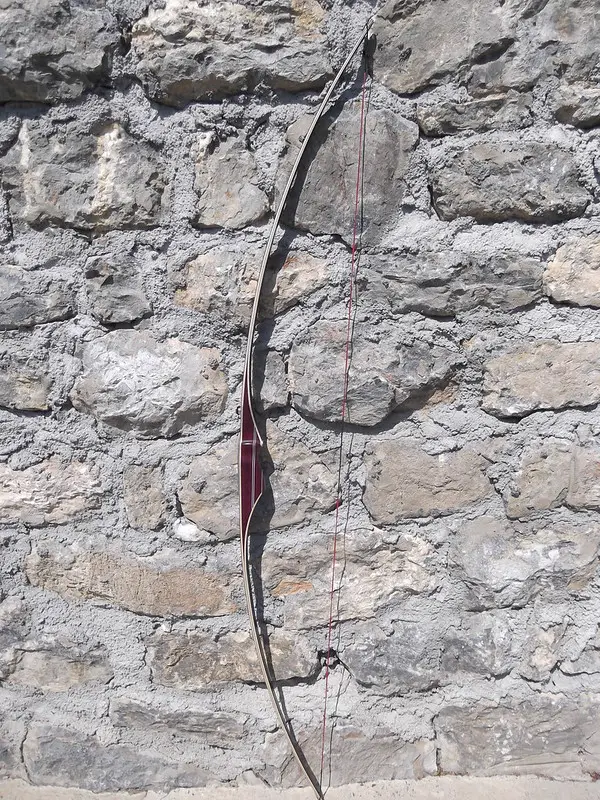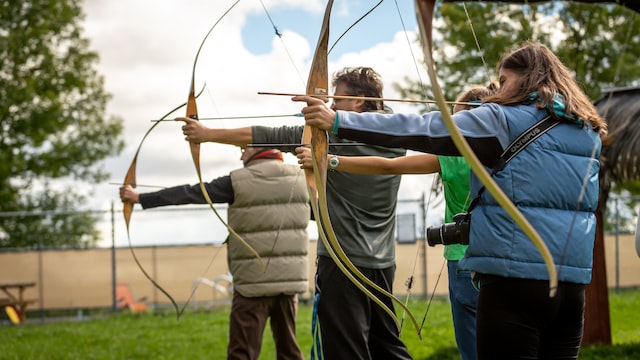The main difference between the longbow and the recurve is the shape of the bow. Longbows are straight, while recurves are slightly curved. This affects how the bow stores and releases energy, which in turn affects accuracy and range. Recurves are generally more accurate than longbows, but longbows can shoot further.
Longbow
(Photo By Vojo Mojović on Flickr)

A longbow is a type of bow that has been used for centuries as a weapon and hunting tool. It is characterized by its simple, traditional design, typically consisting of a single piece of wood that is gently curved along its length. Longbows are known for their long, straight limbs, which give them a distinct appearance. These bows are usually taller than the archer and can range from 5 to 6 feet in length.
Longbows are renowned for their power and range. They are designed to store a significant amount of energy when drawn back and release it efficiently upon release. The longer limbs allow for a longer draw length, which translates into increased arrow speed and distance. Longbows are known for their smooth shooting experience and have been historically used by various cultures, including the English in medieval times.
Traditionally, longbows were made from a single piece of wood, such as yew, ash, or elm. However, modern versions can be made from laminated wood, fiberglass, or other composite materials to enhance their performance. The simplicity of the longbow’s design makes it an appealing choice for archery enthusiasts who appreciate its traditional and elegant form.
Recurve
(Photo by RDNE Stock project )

A recurve bow is a type of bow characterized by its distinctive curved limbs that face away from the archer when unstrung. The name “recurve” comes from the fact that the tips of the limbs curve inwards towards the archer when the bow is unstrung. This design allows the bow to store more energy and deliver higher arrow speeds compared to a straight-limbed bow.
The recurve bow has a long and rich history, dating back thousands of years. It has been used by various cultures around the world for hunting, warfare, and sport. Today, recurve bows are popular in archery competitions, both indoor and outdoor, as well as in Olympic archery events.
The design of a recurve bow allows it to generate more power and velocity compared to other traditional bows like longbows. When the bowstring is drawn back, the limbs flex, storing energy. Upon release, the limbs quickly straighten, transferring the stored energy to the arrow, propelling it forward with greater force.
Recurve bows are typically made from modern materials like fiberglass, carbon fiber, or laminated wood, providing strength and durability. They often consist of three main parts: the riser (central handle), the upper limb, and the lower limb. The riser serves as the grip and attachment point for accessories like sight, stabilizers, and arrow rest.
Recurve bows offer various advantages, including their versatility, portability, and customization options. They can be used for target shooting, hunting, and recreational archery. The design also allows for easier transportation and maneuverability compared to longer bows like longbows.
Overall, the recurve bow combines tradition with modern materials and design, making it a popular choice among archers seeking a balance between performance, aesthetics, and the challenge of shooting a classic bow design.
Longbow Vs. Recurve – Key differences
Longbow and recurve bow are two distinct types of bows with notable differences:
Design: The longbow features a simple, traditional design with long, straight limbs and a gentle curve along its length. In contrast, the recurve bow has limbs that curve away from the archer when unstrung, creating a recurve shape.
Power and Range: Longbows are known for their power and long-range capabilities. They can shoot arrows with substantial force and accuracy over long distances. Recurve bows also possess power and accuracy, but they generally have a slightly shorter effective range compared to longbows.
Size and Maneuverability: Longbows are typically taller than the archer, ranging from 5 to 6 feet in length. This larger size can make them less maneuverable in tight spaces. Recurve bows, on the other hand, are generally more compact and easier to handle, making them suitable for various shooting scenarios.
Shooting Experience: Longbows provide a smooth shooting experience due to their longer limbs, which minimize hand shock and vibrations upon release. Recurve bows also offer a smooth shooting experience, but they can exhibit more stacking (increased draw weight) as the bow is drawn to its maximum, requiring more effort from the archer.
Traditional Appeal vs. Modern Versatility: Longbows carry a traditional and historical appeal, connecting archers to ancient times. Recurve bows offer a blend of tradition and modernity, with more versatility in terms of customization options, accessories, and competitive archery events like the Olympics.
It’s important to note that personal preference, shooting style, and intended use play a significant role in choosing between a longbow and a recurve bow. Both types have their strengths and unique characteristics, appealing to different archers based on their individual preferences and shooting requirements.
The pros and cons a longbow
Pros of a Longbow:
- Power and Range: Longbows are known for their impressive power and range, allowing for accurate shots over long distances.
- Simplicity: Longbows have a simple design, typically made from a single piece of wood, which appeals to archers who prefer traditional equipment.
- Smooth Shooting: The longer limbs of a longbow result in a smooth shooting experience, minimizing hand shock and vibrations upon release.
- Stealth: Longbows can be quieter compared to compound bows or crossbows, making them suitable for hunting and situations requiring stealth.
Cons of a Longbow:
- Skill and Practice: Mastering a longbow requires skill and practice due to its longer length and lack of mechanical aids. It can take time to develop proper technique and accuracy.
- Limited Accessories: Longbows generally have fewer options for accessories and adjustments compared to modern compound bows, which may limit customization.
- Size and Portability: Longbows can be larger and bulkier than other types of bows, making them less convenient for traveling or maneuvering in tight spaces.
- Draw Weight: Longbows typically have a higher draw weight, requiring more physical strength to draw and hold the bow at full draw for longer periods.
It’s important to note that the pros and cons can vary depending on the individual archer’s preferences, shooting style, and intended use of the longbow.
The pros and cons a Recurve
Pros of a Recurve Bow:
- Versatility: Recurve bows are versatile and can be used for various purposes, including target shooting, hunting, and competitions.
- Power and Accuracy: Recurves are known for their power and accuracy, thanks to their curved limbs that store and release energy efficiently.
- Portability: Recurve bows are typically more compact and easier to transport compared to longbows, making them suitable for travel or outdoor adventures.
- Customization: Recurves offer a range of accessories and options for customization, allowing archers to personalize their bow according to their preferences.
Cons of a Recurve Bow:
- Learning Curve: Mastering the recurve bow requires practice and proper technique, especially with the higher poundage models, to achieve consistent accuracy.
- Less Forgiving: Recurve bows are generally less forgiving of minor form errors compared to some modern compound bows. Proper shooting form is crucial.
- Reduced Speed and Range: While recurve bows can be powerful, they may have slightly less speed and range compared to compound bows or longbows.
- Limited Hunting Options: Some hunters may find recurve bows less suitable for long-range hunting or situations requiring high arrow speeds.
It’s important to consider your individual preferences, shooting style, and intended use when evaluating the pros and cons of a recurve bow. Many archers appreciate the recurve bow for its traditional appeal, challenge, and versatility in different archery disciplines.
What kind of bow do Olympic archers use?
Olympic archers predominantly use recurve bows in their competitions. Recurve bows are the only type of bow allowed in Olympic archery events. These bows are chosen for their combination of accuracy, power, and consistency. Olympic recurve bows have specific specifications and regulations to ensure fairness and standardization in competition. They are typically made of advanced materials such as carbon fiber and feature stabilizers, sights, and other accessories to enhance performance. Olympic archers undergo rigorous training and practice to master the recurve bow and compete at the highest level in events like the Olympic Games.
How far can a longbow shoot?
The distance that a longbow or a recurve bow can shoot depends on various factors, including the skill and strength of the archer, the type of bow, arrow weight, and environmental conditions. Generally, both longbows and recurve bows can shoot accurately over considerable distances.
Longbows: With their longer length and powerful limbs, longbows are capable of shooting arrows accurately at ranges of 180 to 250 yards (165 to 229 meters) in skilled hands. However, for practical purposes, most longbow archers typically shoot at targets within 20 to 60 yards (18 to 55 meters) for optimal accuracy.
Recurve Bows: Recurve bows, with their curved limbs and efficient energy transfer, can shoot arrows with good accuracy at ranges of 70 to 90 yards (64 to 82 meters) for experienced archers. In competitive Olympic archery, the standard distance for outdoor events is 70 meters, while indoor events typically involve shooting at 18 or 25 meters.
It’s important to note that these distances are not absolute limits, and individual archers may have different ranges based on their skill level and equipment setup. Additionally, safety and legal regulations should always be followed when shooting a bow to ensure the protection of people and property.
Featured Image By – Alex Guillaume on Unsplash








